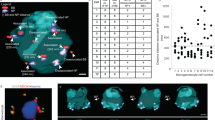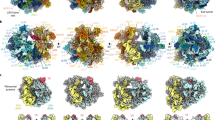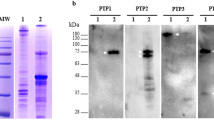Abstract
Microsporidia are obligate intracellular parasites of several eukaryotes. They have a highly complex and unique infection apparatus but otherwise appear structurally simple1. Microsporidia are thought to lack typical eukaryotic organelles, such as mitochondria and peroxisomes. This has been interpreted as support for the hypothesis that these peculiar eukaryotes diverged before the mitochondrial endosymbiosis, which would make them one of the earliest offshoots in eukaryotic evolution2,3. But microsporidial nuclear genes that encode orthologues of typical mitochondrial heatshock Hsp70 proteins have been detected, which provides evidence for secondary loss of the organelle or endosymbiont4,5,6. In addition, gene trees and more sophisticated phylogenetic analyses have recovered microsporidia as the relatives of fungi, rather than as basal eukaryotes7,8,9. Here we show that a highly specific antibody raised against a Trachipleistophora hominis Hsp70 protein detects the presence, under light and electron microscopy, of numerous tiny (∼50 × 90 nm) organelles with double membranes in this human microsporidial parasite. The finding of relictual mitochondria in microsporidia provides further evidence of the reluctance of eukaryotes to lose the mitochondrial organelle, even when its canonical function of aerobic respiration has been apparently lost.
This is a preview of subscription content, access via your institution
Access options
Subscribe to this journal
Receive 51 print issues and online access
$199.00 per year
only $3.90 per issue
Buy this article
- Purchase on Springer Link
- Instant access to full article PDF
Prices may be subject to local taxes which are calculated during checkout




Similar content being viewed by others
References
Vávra, J. & Larsson, J. I. R. in The Microsporidia and Microsporidiosis (eds Wittner, M. & Weiss, L. M.) 7–84 (American Society for Microbiology, Washington DC, 1999)
Cavalier-Smith, T. Eukaryotes with no mitochondria. Nature 326, 332–333 (1987)
Vossbrinck, C. R., Maddox, J. V., Friedman, S., Debrunner-Vossbrinck, B. A. & Woese, C. R. Ribosomal RNA sequence suggests microsporidia are extremely ancient eukaryotes. Nature 326, 411–414 (1987)
Peyretaillade, E. et al. Microsporidia, amitochondrial protists, possess a 70-kDa heat shock protein gene of mitochondrial evolutionary origin. Mol. Biol. Evol. 15, 683–689 (1998)
Hirt, R. P., Healy, B., Vossbrinck, C. R., Canning, E. U. & Embley, T. M. A mitochondrial Hsp70 orthologue in Vairimorpha necatrix: molecular evidence that microsporidia once contained mitochondria. Curr. Biol. 7, 995–998 (1997)
Germot, A., Philippe, H. & Le Guyader, H. Evidence for loss of mitochondria in Microsporidia from a mitochondrial-type HSP70 in Nosema locustae. Mol. Biochem. Parasitol. 87, 159–168 (1997)
Keeling, P. J., Luker, M. A. & Palmer, J. D. Evidence from β-tubulin phylogeny that microsporidia evolved from within the fungi. Mol. Biol. Evol. 17, 23–31 (2000)
Hirt, R. P. et al. Microsporidia are related to Fungi: evidence from the largest subunit of RNA polymerase II and other proteins. Proc. Natl Acad. Sci. USA 96, 580–585 (1999)
Van de Peer, Y., Ben Ali, A. & Meyer, A. Microsporidia: accumulating molecular evidence that a group of amitochondriate and suspectedly primitive eukaryotes are just curious fungi. Gene 246, 1–8 (2000)
Arisue, N., Sanchez, L. B., Weiss, L. M., Müller, M. & Hashimoto, T. Mitochondrial-type hsp70 genes of the amitochondriate protists, Giardia intestinalis, Entamoeba histolytica and two microsporidians. Parasitol. Int. 51, 9–16 (2002)
Fast, N. M. & Keeling, P. J. α and β subunits of pyruvate dehydrogenase E1 from the microsporidian Nosema locustae: mitochondrion-derived carbon metabolism in microsporidia. Mol. Biochem. Parasitol. 117, 201–209 (2001)
Katinka, M. D. et al. Genome sequence and gene compaction of the eukaryote parasite Encephalitozoon cuniculi. Nature 414, 450–453 (2001)
Pfanner, N. & Geissler, A. Versatility of the mitochondrial protein import machinery. Nature Rev. Mol. Cell. Biol. 2, 339–349 (2001)
Winzeler, E. A. et al. Functional characterization of the S. cerevisiae genome by gene deletion and parallel analysis. Science 285, 901–906 (1999)
Bukau, B. & Horwich, A. L. The Hsp70 and Hsp60 chaperone machines. Cell 92, 351–366 (1998)
Lill, R. & Kispal, G. Maturation of cellular Fe-S proteins: an essential function of mitochondria. Trends Biochem. Sci. 25, 352–356 (2000)
Hollister, W. S. et al. Development and ultrastructure of Trachipleistophora hominis n.g., n.sp. after in vitro isolation from an AIDS patient and inoculation into athymic mice. Parasitology 112, 143–154 (1996)
Huynen, M. A., Snel, B., Bork, P. & Gibson, T. J. The phylogenetic distribution of frataxin indicates a role in iron-sulfur cluster protein assembly. Hum. Mol. Genet. 10, 2463–2468 (2001)
Akhmanova, A. et al. A hydrogenosome with a genome. Nature 396, 527–528 (1998)
van Der Giezen, M. et al. Conserved properties of hydrogenosomal and mitochondrial ADP/ATP carriers: a common origin for both organelles. EMBO J. 21, 572–579 (2002)
Dyall, S. D. & Johnson, P. J. Origins of hydrogenosomes and mitochondria: evolution and organelle biogenesis. Curr. Opin. Microbiol. 3, 404–411 (2000)
Tovar, J., Fischer, A. & Clark, C. G. The mitosome, a novel organelle related to mitochondria in the amitochondrial parasite Entamoeba histolytica. Mol. Microbiol. 32, 1013–1021 (1999)
Mai, Z. et al. Hsp60 is targeted to a cryptic mitochondrion-derived organelle (‘crypton’) in the microaerophilic protozoan parasite Entamoeba histolytica. Mol. Cell. Biol. 19, 2198–2205 (1999)
Canning, E. U. in Handbook of Protoctista (eds Margulis, L., Corliss, J. O., Melkonian, M. & Chapman, D. J.) 53–72 (Jones and Bartlett, Boston, 1990)
Roger, A. J. et al. A mitochondrial-like chaperonin 60 gene in Giardia lamblia: evidence that diplomonads once harbored an endosymbiont related to the progenitor of mitochondria. Proc. Natl Acad. Sci. USA 95, 229–234 (1998)
Cheney, S. A., Lafranchi-Tristem, N. J. & Canning, E. U. Serological differentiation of microsporidia with special reference to Trachipleistophora hominis. Parasite 8, 91–97 (2001)
Lockhart, P. J., Steel, M. A., Hendy, M. D. & Penny, D. Recovering evolutionary trees under a more realistic model of sequence evolution. Mol. Biol. Evol. 11, 605–612 (1994)
Wilbanks, S. in Guidebook to the Molecular Chaperones and Protein-Folding Catalysts (ed. Gething, M.-J. H.) 13–18 (Oxford Univ. Press, New York, 1997)
Buchberger, A. & Bukau, B. in Guidebook to the Molecular Chaperones and Protein-Folding Catalysts (ed. Gething, M.-J. H.) 22–25 (Oxford Univ. Press, New York, 1997)
Acknowledgements
We thank E. Canning for the T. hominis culture system and advice on growing microsporidia; M. Duchen and A. Ball for help with confocal microscopy; C. Thomson for help with electron microscopy; and C. Danpure and G. Birdsey for comments on the manuscript and help with heterologous transfection experiments. J.M.L. was supported by a Wellcome Trust Research Leave Fellowship and Tenovus Scotland. B.A.P.W. was supported by a Wellcome Trust Biodiversity studentship, R.P.H. was supported by a Wellcome Trust University award.
Author information
Authors and Affiliations
Corresponding author
Ethics declarations
Competing interests
The authors declare that they have no competing financial interests.
Rights and permissions
About this article
Cite this article
Williams, B., Hirt, R., Lucocq, J. et al. A mitochondrial remnant in the microsporidian Trachipleistophora hominis. Nature 418, 865–869 (2002). https://doi.org/10.1038/nature00949
Received:
Accepted:
Issue Date:
DOI: https://doi.org/10.1038/nature00949
This article is cited by
-
Molecular and cellular characterization of four putative nucleotide transporters from the shrimp microsporidian Enterocytozoon hepatopenaei (EHP)
Scientific Reports (2023)
-
Effects of oxygen availability on mycobenthic communities of marine coastal sediments
Scientific Reports (2023)
-
Energy metabolism and its evolution in Microsporidia and allied taxa
Parasitology Research (2020)
Comments
By submitting a comment you agree to abide by our Terms and Community Guidelines. If you find something abusive or that does not comply with our terms or guidelines please flag it as inappropriate.



